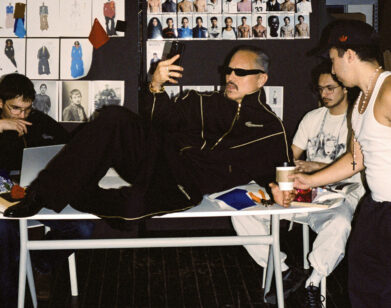Nadège Vanhée-Cybulski
When Nadège Vanhée-Cybulski was named artistic director of Hermès’s women’s ready-to-wear in 2014, it was noteworthy. In a challenging time for the luxury market—particularly the French luxury market—such a decision at a major heritage house is always going to generate headlines. But in this case, the industry was as much struck by the quiet assurance of Hermès’s choice as by its economic import. Vanhée-Cybulski is herself something of a study in discreet elegance. In an era when many designers seem to crave celebrity and all that it implies, Vanhée-Cybulski is a notable exception: She is a designer’s designer with no interest in the spotlight. Words used by the press to describe her include “enigmatic,” “mysterious,” and “discreet”—not because she’s reclusive or uncooperative; she simply isn’t interested in making her own life the story. That, after all, is the work’s job.
Born in 1978, Vanhée-Cybulski grew up in northern France and attended Belgium’s Royal Academy of Fine Arts Antwerp. From 2005 to 2008, she worked for (the also private) Martin Margiela, before moving to London for a three-year stint at Phoebe Philo’s Céline, and then the Row in New York. In short, Vanhée-Cybulski has built up an impeccable reputation for minimalist elegance that doesn’t sacrifice femininity.
In succeeding Christophe Lemaire at Hermès, Vanhée-Cybulski joins a long line of creative women at the brand: Hermès is notable among luxury houses for employing women designers, such as Lola Prusac, Catherine de Karolyi, and Nicole de Vésian, and did so as early as the 1920s. That said, Vanhée-Cybulski is the first women’s ready-to-wear artistic director in 20 years. And at the beginning of Paris’s haute-couture week this past summer, the brand signaled its commitment to ready-to-wear by holding its first pre-collection presentation, a discreet affair that showcased a restrained attitude that matched her aesthetic. And, of course, it showcased her cool: The music was provided-live—by Jarvis Cocker and harpist Serafina Steer.
The collections have been hailed for their elegance and craftsmanship; one writer referred to the Resort 2017 line as “a master class in refined intimacy.” Particularly popular, appropriately, are the leather pieces: reworkings of classics that draw both on Vanhée-Cybulski’s avant-garde background and the company’s archive. The designer cited as inspiration both 17th-century Dutch flower paintings and a Henrik Wergeland poem they inspired—a characteristically thoughtful and layered approach.
Despite her reputation for mystery, when we speak on the phone between Paris and New York, Vanhée-Cybulski is warm and charming. She simply wants to do her work and do it well. And that, nowadays, is quietly revolutionary.
SADIE STEIN: First, I’m sure everyone asks you this all the time, but I wanted to know if you’re related to Zbigniew Cybulski.
NADÈGE VANHÉE-CYBULSKI: Who?
STEIN: The Polish actor.
VANHÉE-CYBULSKI: Oh, the Polish actor! Actually, my husband and I are used to that question. We are not related to him, but every time we would go to this airport, there was a Polish stewardess who asked that question. My husband kind of looks Polish, so …
STEIN: Zbigniew Cybulski died young, hopping a train.
VANHÉE-CYBULSKI: Yes, he was sort of a Polish James Dean. You know, it’s funny. We get that question more in New York than we do in Europe.
STEIN: Well, I asked and I’m in New York, so that makes sense. Do you enjoy film?
VANHÉE-CYBULSKI: I love films. I love documentary, and I love science fiction. My taste is quite broad.
STEIN: What have you seen lately that you loved?
VANHÉE-CYBULSKI: Yesterday my husband and I saw a French movie that takes place in Afghanistan with French soldiers. It’s called Ni le ciel ni la terre, and something quite mystical happens halfway through. Then there is Touching the Void [2004], about two English kids who climb a mountain in South America and have a serious incident. It’s a great story about the massive determination of survival.
STEIN: It’s a bit like reverse escapism. So when did you first become interested in fashion design? Or was it always your dream?
VANHÉE-CYBULSKI: I never really understood fashion as a career. For me, it was really a state of mind, more like something that I always had in my life. As a kid, fashion magazines were always accessible to me, so I grew up with it. But there was also the fashion of my mom or even my own closet. It was always something that I loved, that I was impregnated with. When I was a teenager, I loved going into my friends’ closets, going to vintage shops. For me, the look of the ’60s and the ’70s, I always loved it.
STEIN: Had you grown up with Hermès?
VANHÉE-CYBULSKI: Hermès is such a French institution. And different generations have different understandings of Hermès, so as a French woman, I had my personal idea of Hermès; that was the scarves that belonged to the women in my family, and the famous leather bags.
STEIN: And, of course, Hermès is unusual in that there’s a history of women as designers; how do you feel about that particular lineage?
VANHÉE-CYBULSKI: It was a very natural fit. There was always a strong sense of femininity in the house, always that presence. And while it wasn’t founded by a woman, the family always had this brilliant intuition for being surrounded by great women. Not that I am a great woman—I don’t want to say that!—but there were always great women in different ages who had really a strong idea of style and could really translate the know-how of the house. When I see the work of Catherine de Karolyi [fashion designer who created Hermès’s first ready-to-wear collection, in 1967], and the way she plays with artifacts of the equestrian world and relates them to the fashion of the ’60s and ’70s, it’s quite interesting. There is a femininity there that makes you feel welcome.
STEIN: One thing I always wonder, especially when you start at such a storied house, is how you begin the process of study, of immersing yourself in the archives? Do you devote weeks to that kind of research?
VANHÉE-CYBULSKI: For me, there was always a strong ground. And when I arrived, the process worked in a very intuitive way. It’s not that I lock myself in the library. People always talk about the archives, but for me, it is more about the people and their testimony. There is a heritage that is translated through people-the director, the craftsmen, the heads of certain disciplines. That helped my knowledge.
STEIN: How can you pay respect to a tradition, while avoiding the trap of nostalgia?
VANHÉE-CYBULSKI: There is not an inch of nostalgia in Hermès. Heritage is not necessarily hammered with nostalgia. Heritage is like DNA in a way. It’s a code that is there, but it actually enables you to live today. I don’t need to think of balancing it because it’s really more innate. For ready-to-wear, you don’t have time to be nostalgic; it’s good that it’s there, and you can use what you want and how to process it and work with it.
STEIN: You’ve worked with Margiela, Céline, and the Row. How did you reconcile your own minimalist aesthetic with the company’s traditions when you arrived?
VANHÉE-CYBULSKI: I really wanted to understand the roots of the house, which is saddlemaking. I was really looking for this purity of a shape and the autonomy of that shape, and also the fusion between the man and the animal.
STEIN: Do you ride horses yourself?
VANHÉE-CYBULSKI: No. They are beautiful creatures, but I think I am too fidgety to ride a horse. They have a sense for that.
STEIN: I feel the same. I’ve never been on a horse in my life. It seems like such a mystical thing when people are great with horses.
VANHÉE-CYBULSKI: Yes, I think it is mystical. It’s like a magical power.
STEIN: In reading over previous interviews you’ve done, you don’t seem interested in casting yourself as a celebrity designer. Would you say that’s true?
VANHÉE-CYBULSKI: Yes. For me, this job is too collective to take all the credit. It’s almost obnoxious to say, “It’s all mine.” And that goes back to the idea of being balanced, in a sense, and understanding reality. You have to live in reality. I also just want freedom.
STEIN: I imagine humility brings something very interesting to a collection. I think humility can be a great friend.
VANHÉE-CYBULSKI: Yes, totally.
STEIN: Maybe that is a more feminine attitude?
VANHÉE-CYBULSKI: I don’t know if it is purely femininity—you also have a lot of great male artists who are extraordinary and have a great sense of humility. I think it is about respect, because it enables a person to better understand the work in its own right. It’s a kind of respect for the customer. It’s very tricky to explain a collection too much. I think it should come down to something you feel.
STEIN: A sympathy between women and clothes.
VANHÉE-CYBULSKI: People’s connection to their clothes is very interesting. And rather than my own exposure, I would rather have the clothes be reachable and for people to be able to make those connections on their own.
STEIN: Nevertheless, your job must be so all-encompassing. Does everything go into the work, or are you able to find ways to get away mentally, like through books or music?
VANHÉE-CYBULSKI: I was reading Tom Wolfe’s The Kingdom of Speech, and I really, really liked it. Of course, I am a human being and have outside activities. But, yes, as a fashion designer, you absorb images, books, color, behavior, music, art. It really effects all senses.
STEIN: There are so many great shows going on in Paris right now. I was just there and saw the most amazing Oscar Wilde show.
VANHÉE-CYBULSKI: I love Oscar Wilde.
STEIN: There was also this museum I had never heard of that a friend told me to visit, the Musée de la Chasse et de la Nature [A small museum in the Marais that focuses on the relationship between humans and animals].
VANHÉE-CYBULSKI: [gasps] Isn’t it amazing?
STEIN: The way the art is integrated is so smart and chic. It was one of the best museums I had ever seen.
VANHÉE-CYBULSKI: It’s a great museum. There’s also the Judaism museum [Musée d’art et d’histoire du Judaisme], which is great. We have the Louvre and the d’Orsay, but we also have the culture of tiny, specific museums, which have these unexpected things.
STEIN: Completely. And in the end, that hunting museum is actually saying a lot about humanity and its relationship to the natural world. By focusing on something small, it was huge.
VANHÉE-CYBULSKI: That is what is so great about Paris. You should go to an artist museum you would never otherwise see. It’s called the Musée de la Vie Romantique!
STEIN: Oh, I love it. It’s so beautiful. That little house!
VANHÉE-CYBULSKI: Yes, that’s the quirkiest museum I have seen anywhere.
STEIN: Is there anything you have on the horizon you’re especially excited about? It could be anything.
VANHÉE-CYBULSKI: Oh, I have so much on the horizon. My husband just opened a gallery [Galerie PCP, in the Marais] and that is a very exciting prospect. So that is what I would say.







